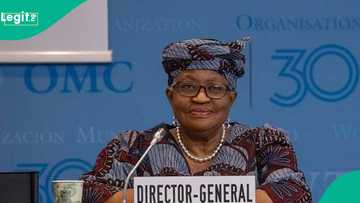Nigeria’s World Bank Debt Hits $18.2bn: Rising Borrowing Pushes Per Capita Burden Higher
- Nigeria has continued to rank as the third-largest debtor to the World Bank’s International Development Association (IDA)
- The country’s total obligation hit $18,2 billion as of June 30, 2025, a sharp rise from $16.5bn in June last year
- The debt has also raised the country’s debt per capita, sparking fears about sustainability amid dwindling revenue
Legit.ng’s Pascal Oparada has reported on tech, energy, stocks, investment and the economy for over a decade.
Nigeria has maintained its position as the third-largest debtor to the World Bank’s International Development Association (IDA), with total obligations hitting $18.2bn as of June 30, 2025.
The figure marks a sharp rise from $16.5bn in June 2024, representing a $1.7bn or 10.3% increase in just one year.

Source: Twitter
Rising debt and per capita implications
This ranking, first attained in 2024, underscores Nigeria’s continued reliance on concessional loans despite the IDA’s generous repayment terms and long maturities. Only Bangladesh ($22.6bn) and Pakistan ($19.3bn) owe more to the lender.

Read also
50m dollars global fund lands in Nigeria: Okonjo-Iweala backs women entrepreneurs in digital trade
While IDA loans are considered cheaper than commercial borrowing, the growing debt stock has direct implications for Nigeria’s citizens.
With Nigeria’s population estimated at over 220 million, the $18.2bn exposure translates into an average debt per capita of about $83, up from $75 the previous year.
Economists warn that this figure could climb higher if Nigeria continues to rely heavily on external financing for budget support, energy access, and poverty reduction.
As revenues remain weak, every new loan effectively deepens the debt responsibility borne by ordinary Nigerians.
Global rankings and shifting trends
The IDA’s 2025 exposure report reveals major shifts among top borrowers. While Bangladesh and Pakistan recorded significant increases, India reduced its debt stock from $15.9bn to $14.2bn, reflecting higher repayments than fresh disbursements.
Ethiopia, Tanzania, and Kenya also saw notable increases, with Tanzania surpassing Kenya in the rankings.
Ghana, Côte d’Ivoire, and Vietnam completed the top ten, highlighting how Sub-Saharan Africa’s reliance on concessional loans is deepening amid fiscal stress.
Overall, the IDA’s top ten borrowers accounted for 61% of its loan exposure in 2025.
Nigeria’s growing reliance on World Bank funding
Between June 2023 and June 2025, Nigeria secured at least $3.9bn in new IDA loans, in addition to loans from the World Bank’s International Bank for Reconstruction and Development (IBRD).
By March 2025, Nigeria’s total debt to the World Bank had reached $18.23bn, accounting for nearly 40% of its total external debt stock of $45.98bn.
This concentration underscores the central role of World Bank financing in Nigeria’s fiscal framework.
Multilateral debt now represents over 81% of Nigeria’s multilateral borrowing, raising concerns over the country’s rising vulnerability to external lenders.
Experts raise red flags on sustainability
Dr Muda Yusuf, CEO of the Centre for the Promotion of Private Enterprise, stressed that while borrowing is not inherently wrong, debt sustainability is the critical issue.
He warned that Nigeria risks falling into a cycle of borrowing to service old debts, particularly if revenue mobilisation remains weak.
“Without strong cash flow to meet repayment schedules, Nigeria may find itself in a fiscal trap,” he said, noting that exchange rate pressures make foreign loans riskier than domestic debt.
Experts argue that loan-funded projects must directly boost Nigeria’s revenue-generating capacity, such as infrastructure that drives trade, energy reforms, and agricultural investments; otherwise, the debt burden will continue to weigh heavily on citizens.
What this means for Nigerians
The steady accumulation of concessional debt has placed Nigeria in a delicate position.
While IDA funding has supported critical sectors, energy, healthcare, education, and governance, the country’s rising debt per capita signals that citizens are paying more for government borrowing than ever before.

Source: Facebook
Unless reforms strengthen revenue collection and reduce fiscal leakages, Nigeria’s presence near the top of the global IDA debtor table could translate into long-term fiscal stress, squeezing future generations.
DMO releases list of Nigeria's top creditors
Legit.ng earlier reported that Nigeria’s public debt stood at $97.23 billion or N149.39 trillion as of the end of March 2025.
This is according to the latest data from the Debt Management Office (DMO), which covers the nation’s debt up to March 31, 2025.
The latest figure represents a 22.8% yearly growth amounting to N27.72 trillion, up from the N121.67 trillion recorded as of March 31, 2024.
Source: Legit.ng




